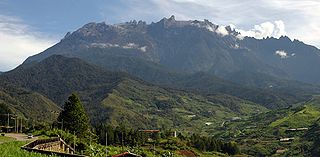
Mount Kinabalu is the highest mountain in Borneo and Malaysia. With an elevation of 13,435 feet (4,095 m), it is third-highest peak of an island on Earth, and 20th most prominent mountain in the world by topographic prominence. The mountain is located in Ranau district, West Coast Division of Sabah, Malaysia. It is protected as Kinabalu Park, a World Heritage Site.
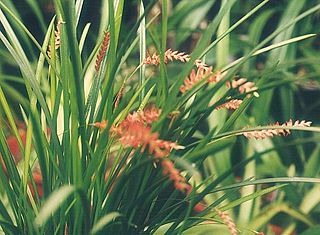
Dendrochilum is a genus of epiphytic, lithophytic and a few terrestrial flowering plants in the orchid family (Orchidaceae). The name of this genus is derived from Ancient Greek words dendron ("tree"), and either cheilos ("lip") or chilos, alluding to either the flowers' large lip or to their epiphytic growth. These orchids are popular among fans of non-traditional orchid curiosities.

Nepenthes reinwardtiana is a tropical pitcher plant native to Borneo and Sumatra and to a number of smaller surrounding islands including Bangka, Natuna, Nias, and Siberut. Although some sources have included Peninsular Malaysia and Singapore within the range of this species, these records appear to be erroneous.
Datuk Anthony L. Lamb M.A., Dip. Ag., D.T.A., P.G.D.K. is a British botanist, born in British Ceylon and specializing in the flora of Sabah, East Malaysia, on the northwest portion of the island of Borneo. Lamb was educated in the United Kingdom, at Blundell's School in Tiverton and at St John's College at Cambridge. Lamb arrived in Sabah, then part of the British Crown Colony of North Borneo, in 1962 and started work on developing agricultural settlement schemes around Tawau.
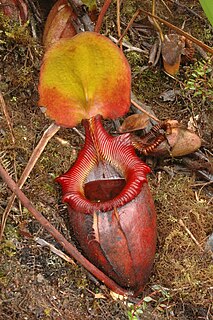
Nepenthes × kinabaluensis, or the Kinabalu pitcher-plant, is the natural hybrid between N. rajah and N. villosa. It was first collected near Kambarangoh on Mount Kinabalu, Borneo by Lilian Gibbs in 1910 and later mentioned by John Muirhead Macfarlane as "Nepenthes sp." in 1914. Although Macfarlane did not formally name the plant, he noted that "[a]ll available morphological details suggest that this is a hybrid between N. villosa and N. rajah". It was finally described in 1976 by Shigeo Kurata as N. × kinabaluensis. The name was first published in Nepenthes of Mount Kinabalu, but was a nomen nudum at the time as it lacked an adequate description and information on the type specimen. The name was subsequently published validly by Kurata in 1984.
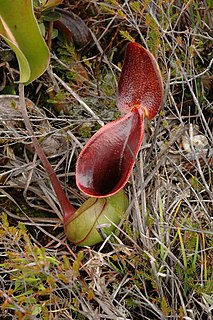
Nepenthes lowii, or Low's pitcher-plant, is a tropical pitcher plant endemic to Borneo. It is named after Hugh Low, who discovered it on Mount Kinabalu. This species is perhaps the most unusual in the genus, being characterised by its strongly constricted upper pitchers, which bear a greatly reduced peristome and a reflexed lid with numerous bristles on its lower surface.

Nepenthes macrovulgaris, or the serpentine pitcher-plant, is a tropical pitcher plant endemic to Borneo. It is a lowland plant that typically grows at altitudes ranging from 300 to 1200 m in sub-montane forest clearings and mossy forest. Its range is restricted to ultramafic habitats, including Mount Kinabalu, Mount Tambuyukon, the Danum Valley, the Tawai Range, the Meliau Range and Mount Silam, all in Sabah, Malaysian Borneo. Pitchers grow to around 25 cm high and range in colour from green to brown, with the speckled form being the most common.

Nepenthes stenophylla, or the narrow-leaved pitcher-plant, is a tropical pitcher plant endemic to Borneo. The species produces attractive funnel-shaped pitchers up to 25 cm high. It is listed as Least Concern on the IUCN Red List. Nepenthes stenophylla belongs to the loosely defined "N. maxima complex", which also includes, among other species, N. boschiana, N. chaniana, N. epiphytica, N. eymae, N. faizaliana, N. fusca, N. klossii, N. maxima, N. platychila, and N. vogelii.

Nepenthes × alisaputrana, or the leopard pitcher-plant, is a hybrid of two well-known Nepenthes pitcher plant species: N. burbidgeae and N. rajah. The plant is confined to Mount Kinabalu in Sabah, Borneo.

Nepenthes murudensis, or the Murud pitcher-plant, is a tropical pitcher plant endemic to Mount Murud in Borneo, after which it is named. It is of putative hybrid origin: its two original parent species are thought to be N. reinwardtiana and N. tentaculata.
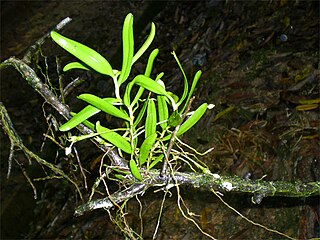
Thrixspermum trichoglottis is a monopodial orchid in the subfamily Epidendroideae. It is widespread across the eastern Himalayas, Yunnan, Indochina, the Andaman & Nicobar Islands, Malaysia and western Indonesia.

Dendrobium compressum is a species of orchid. It is native to Thailand, Malaysia, Myanmar, Borneo, Java, and Sumatra.
Dendrobium platycaulon is a species of orchid native to Borneo and the Philippines.

Dendrobium secundum, also known as the toothbrush orchid, is a species of flowering plant in the genus Dendrobium of the family Orchidaceae. The common name refers to the fact that all the flowers are on the same side of the stem, much like the bristles all on one side of a toothbrush.
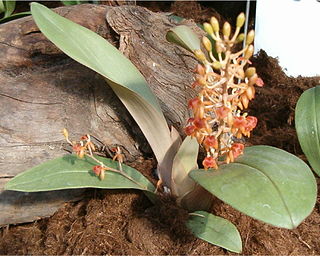
Liparis latifolia is a species of orchid native to Hainan, Thailand, Indonesia, Malaysia, the Philippines and New Guinea.

Thrixspermum calceolus, commonly called the small shoe-carrying thrixspermum, is a species of orchid native to Thailand, Vietnam, Borneo, Malaysia and Sumatra. They can be found as epiphytes or lithophytes in lower evergreen and semideciduous montane forests. The orchids are climbing or creeping with their roots found along the length stems. White flowers with fragrant can be found in summer. There are often 2 to 3 flowers per node.
Bulbophyllum muscohaerens is a species of orchid in the genus Bulbophyllum. It was found in Boneo.
Porrorhachis is a genus of flowering plants from the orchid family, Orchidaceae. It contains two known species, both native to Southeast Asia.

Dendrobium uniflorum is a member of the family Orchidaceae. It is native to the Malesia and Southeast Asia regions, in Thailand, Vietnam, Malaysia, Philippines, Borneo, Sulawesi, Sumatra.

Dendrobieae is a tribe in the subfamily Epidendroideae, in the family Orchidaceae. The Dendrobieae are mostly tropical, epiphytic orchids which contain pseudobulbs.
















